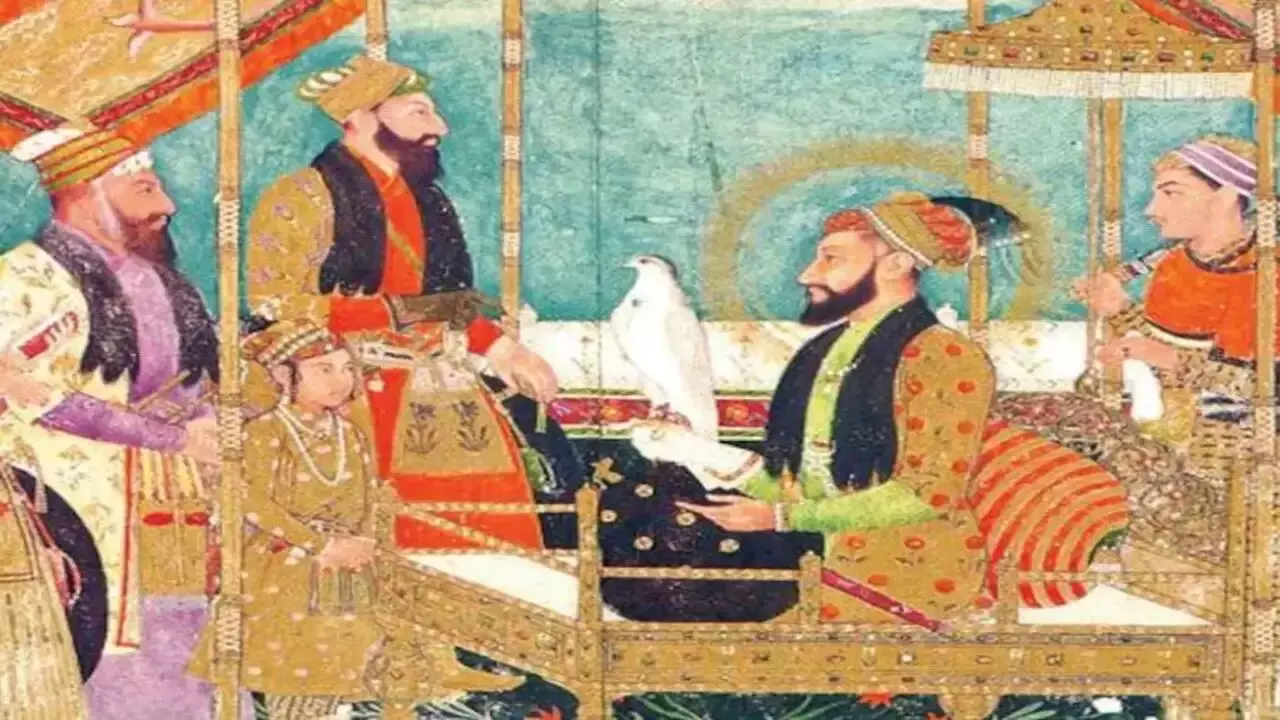TRENDING TAGS :
The Golden Era of Cultural Harmony and Poetic Art: Understanding the Literary Legacy of the Mughal Court
Explore the rich literary legacy of the Mughal court, where Persian, Urdu, Hindi, and Sanskrit flourished in harmony, creating a golden era of cultural unity, poetic brilliance, and timeless creativity.
Mughal Court (PC- Social Media)
The literary legacy of the Mughal court was not limited to royal grandeur alone, but it profoundly enriched the soul of Indian literature. This was the era when the elegance of Persian, the tenderness of Hindi, the sophistication of Urdu, and the philosophy of Sanskrit converged on a shared platform. The literary accomplishments of this period continue to be a pride of Indian culture and present a marvelous example of unity, harmony, and diversity.
Mughal rulers not only promoted literature but also greatly encouraged painting and fine arts. Miniature painting flourished in their courts, reflecting a beautiful fusion of Persian style and Indian elements. During Akbar’s reign, art saw remarkable growth, as artists were encouraged to illustrate historical texts, religious tales, and royal life. Jahangir himself was a keen connoisseur of nature and painting and promoted a realistic style. With such patronage, the Mughal court became not only a literary hub but also a grand center of art and culture.
The Peak of Persian Literature
Persian was given special prominence in the Mughal court, serving not only as the principal administrative language but also as the primary medium of literary expression. Poets and writers in Persian were highly respected, and the promotion of Persian literature was a key element of Mughal cultural policy. Babur wrote his autobiography “Baburnama” in his native Chagatai (Turkic), which was later translated into Persian for the court. During Humayun’s time, literary activities were relatively limited, but he did offer patronage to Persian scholars and artists, thereby strengthening Persian traditions.
Akbar’s reign is considered the golden age of Persian literature. His court included legendary scholars such as Abul Fazl, Faizi, and Badauni. Abul Fazl’s works Ain-i-Akbari and Akbarnama are extremely valuable both historically and literarily, while Faizi’s poetry exhibits Sufi thought and deep intellectual insight.
Translation Endeavors and Literary Synthesis
To encourage cultural integration between Indian and Islamic traditions, Akbar established a “Translation Department” (Maktabkhana) in Fatehpur Sikri in 1574. Its aim was to translate great works from various languages into Persian. Under this initiative, texts from Sanskrit, Arabic, and other languages were rendered into Persian, building a bridge between two cultural currents.
The Mahabharata was translated and became known as Razmnama, with contributions from many scholars. The Ramayana was translated by Abdul Qadir Badauni and came to be known as Ramayana-e-Akbari. In addition, the Upanishads, Gita, Yogavashishta, and Simhasana Battisi were also translated into Persian. These translations were not mere language conversions; they represented a meaningful attempt to connect Indian philosophy and values with the Persian-Islamic world. They reflected Akbar’s inclusive vision and cultural unity.
Development of Urdu Language
Urdu began evolving during the Delhi Sultanate period, but it flourished under the Mughals. A blend of Hindi, Persian, Turkish, and Arabic, it gradually became a powerful medium of everyday expression. Especially under Shah Jahan and Aurangzeb, Urdu literature gained significant courtly patronage.
In the Deccan, the courts of Golconda and Bijapur promoted Dakhini Urdu, which later inspired poets in Delhi. Wali Mohammed Wali, also known as Wali Dakhni, is regarded as the father of the Urdu ghazal. He incorporated Persian poetic traditions into Urdu using Indian idioms and themes, giving Urdu poetry a new identity. After his visit to Delhi, the popularity of Urdu ghazals soared in North India.
This period also saw the rise of poets like Sarmad, a Jewish-origin Sufi, who composed deeply emotional works in both Persian and Urdu, enriching the literary diversity of the Mughal era.
Impact on Hindi Literature
Though Persian remained the dominant language of the court, several Mughal emperors, including Akbar, supported Hindi literature, particularly Brajbhasha and Awadhi. Hindi poets were given space in the court, and many scholars composed poetry under royal patronage.
While legendary poets like Tulsidas and Surdas were not directly affiliated with the Mughal court, their works received widespread public support and were indirectly influenced by the sociocultural environment of the time.
Muslim poets such as Raskhan and Abdul Rahim Khan-e-Khana (Rahim) composed magnificent works in Brajbhasha. Raskhan’s verses are full of Krishna devotion and romantic sentiment, while Rahim, one of Akbar’s Navratnas, is still famous for his couplets on wisdom and morality. His doha — “Bada hua to kya hua jaise ped khajoor…” — reflects his deep impact both in court and among the masses.
Bahadur Shah Zafar and the Final Literary Tradition
Bahadur Shah Zafar, the last Mughal emperor, was not only a ruler but also a sensitive and gifted poet. During his reign, the Delhi court became a thriving center of Urdu poetry. Poets such as Mirza Ghalib, Zauq, Momin, and Daagh graced his court and elevated its literary atmosphere.
Ghalib’s contributions in both Persian and Urdu prose and poetry were unmatched. Bahadur Shah Zafar’s famous couplet — “Lagta nahin hai dil mera ujade dayar mein, kiski bani hai aalam-e-na-payedar mein” — expresses not only personal sorrow but also immortalizes the pain of political and cultural decline of the era. His literary contribution symbolizes the final flicker of Mughal literary glory.
Communal Harmony through Literature
The literary policies of the Mughal court were deeply pluralistic. Akbar’s principle of Sulh-e-Kul (peace with all) played a major role. This policy rejected discrimination based on religion, caste, or language, granting equal respect and patronage to all communities’ writers, artists, and scholars.
The Mughal Empire fostered an environment of religious, linguistic, and cultural amalgamation, which gave Indian literature a rich, diverse, and inclusive character. This intermingling brought new dimensions to Sufi and Bhakti literature in Hindi, Persian, Urdu, and Brajbhasha and led to the creation of exceptional literary works.
The Union of Painting and Literature
During the Mughal period, literature was not confined to writing alone — it was also visually enriched through paintings. Especially during Akbar’s reign, Persian manuscripts were adorned with beautiful miniature illustrations, exemplifying the fusion of literature and art.
Works like Razmnama (Persian Mahabharata) and Ain-e-Akbari are notable not just for their literary merit but also for their artistic illustrations. Akbar’s court had hundreds of painters who combined Indian and Iranian styles to decorate these manuscripts. These illustrations vividly depicted Indian culture, costumes, nature, animals, birds, and architecture.
Conclusion
The literary legacy of the Mughal court is not just a relic of royal grandeur — it is an enduring testament to India’s cultural richness, linguistic plurality, and civilizational dialogue. It provided fertile ground for poets and scholars across traditions to create, collaborate, and celebrate the power of words — a legacy that continues to inspire to this day.


